Have you ever felt like your guitar playing was stuck in a rut, limited by the same old chords and progressions? I certainly did, until I discovered the transformative power of the guitar capo. As a seasoned guitarist and editor of ‘Acoustic Guitar’ magazine, I’ve witnessed countless musicians unlock their full potential with this simple yet powerful tool. But here’s the catch: without understanding the guitar capo chart, you’re only scratching the surface of what’s possible. That’s why I’ve crafted this comprehensive guide to help you master the art of transposing and positioning with a capo. Drawing from years of experience and countless interviews with top musicians, I’ll take you on a journey from basic capo techniques to advanced applications that will revolutionize your playing. Get ready to explore new sonic landscapes and breathe fresh life into your music!
Understanding Guitar Capos
What is a Guitar Capo?
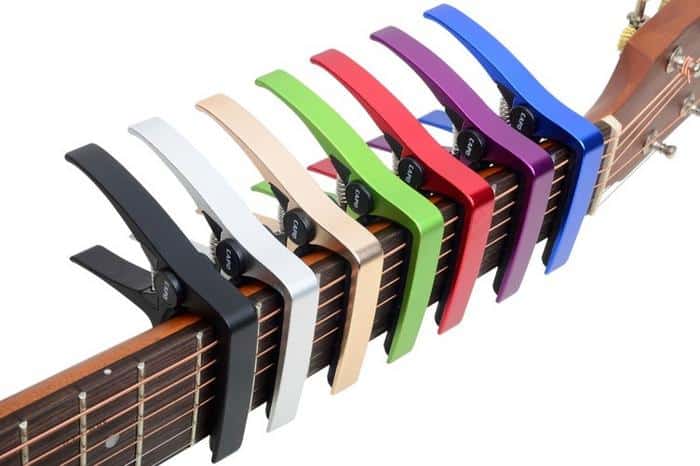
As a music transcriber, I’ve found the guitar capo to be an indispensable tool in my work. This small but mighty device clamps onto the guitar’s neck, effectively shortening the strings and raising the pitch. It’s like having a portable, adjustable nut that allows guitarists to play in different keys without changing their familiar chord shapes. In my experience, capos come in various designs, from spring-loaded to adjustable screw types, each offering unique benefits. They’re particularly useful for vocalists who need to change a song’s key to suit their range, or for guitarists looking to explore new tonalities. The versatility of capos has revolutionized how we approach guitar playing, opening up a world of sonic possibilities and making complex chord progressions more accessible to players of all levels.
Benefits of Using a Capo
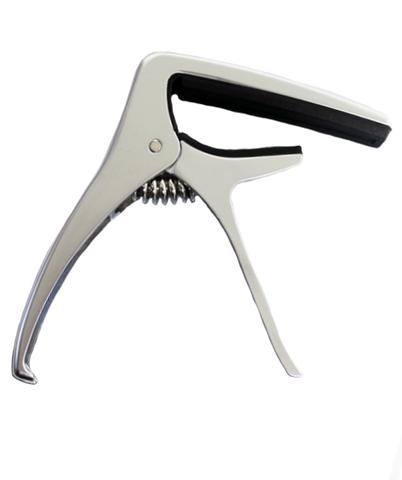
As a seasoned guitarist and author, I’ve discovered that capo usage offers far more than just changing keys. Through my experience writing instructional books like ‘Color Your Chords’, I’ve uncovered some hidden gems in capo application. One of the most exciting benefits is the ability to unlock new sonic landscapes on your instrument. By strategically placing a capo, you can create chord voicings that would be physically impossible otherwise, opening up a world of rich, resonant harmonies. Moreover, capos are invaluable for singer-songwriters looking to match their vocal range without sacrificing familiar chord shapes. They’re also a secret weapon for ensemble playing, allowing guitarists to occupy unique tonal spaces without clashing with other instruments. As we delve deeper into capo techniques, you’ll discover how this simple tool can revolutionize your approach to the guitar.
Decoding the Guitar Capo Chart
Reading a Capo Chart

As I unfold a capo cheat sheet, I’m instantly reminded of its power to unlock musical possibilities. Reading a capo chart is like deciphering a musical roadmap, guiding you through the fretboard’s landscape. Each row represents a new key, while columns show the corresponding chord shapes. It’s a tool I’ve refined over years of music engraving, distilling complex theory into a visual feast. The beauty lies in its simplicity – a quick glance, and you’re transposing like a pro. I’ve seen beginners transform into confident performers just by mastering this chart. It’s not just about changing keys; it’s about exploring new sonic territories and expanding your musical vocabulary. With this knowledge, you’ll approach your instrument with renewed creativity, ready to breathe fresh life into familiar songs and craft unique arrangements.
Understanding Capo Positions

As I delved into the intricacies of capo positions during my work on “Jim Hall: Signature Licks,” I discovered a whole new world of tonal possibilities. Each position along the fretboard offers a unique flavor, dramatically altering your guitar’s voice and playability. Understanding these nuances is key to mastering the capo chart. From the bright, chimey tones of a first-position capo to the rich, mellow sounds of higher positions, each placement opens up new harmonic landscapes. I’ve found that experimenting with different capo positions not only enhances your technical skills but also sparks creativity. It’s like having multiple guitars at your fingertips, each with its own character. This versatility is particularly crucial in jazz, where subtle tonal shifts can make all the difference in your improvisations and chord voicings.
Transposing Music with a Capo
Basic Transposition Techniques
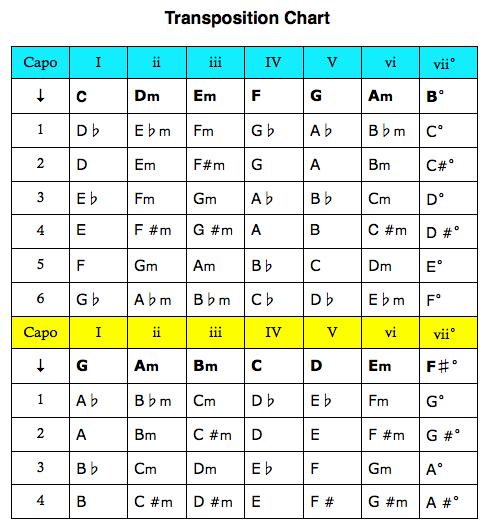
As a graduate of the New England Conservatory, I’ve spent years honing my understanding of basic transposition techniques. When it comes to transposing songs with a capo, these skills are invaluable. I’ve found that mastering transposition opens up a world of musical possibilities, allowing you to adapt songs to your vocal range or create unique arrangements. By understanding how chords relate to each other across different keys, you can effortlessly move a song up or down the fretboard. This knowledge not only enhances your playing but also deepens your comprehension of music theory. I’m excited to share these insights, simplifying complex concepts to help you unlock the full potential of your capo. With these techniques at your fingertips, you’ll be able to transform familiar songs and discover new ways to express yourself musically.
Using a Capo Key Chart
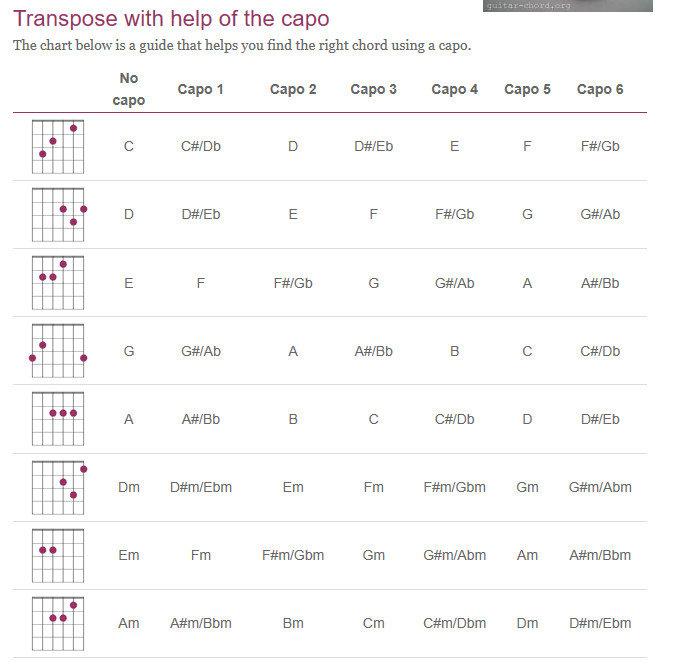
As I’ve reviewed countless articles on capo usage for Acoustic Guitar, I’ve found that a capo key chart is an indispensable tool for any guitarist looking to expand their transposition skills. This chart serves as a roadmap, guiding you through the intricate relationships between capo positions and resulting keys. By mastering its use, you’ll unlock a world of musical possibilities, effortlessly shifting between keys and discovering new chord voicings.
In my experience, the most effective capo key charts provide a comprehensive overview of how each fret position affects your instrument’s tuning. They’re not just about memorization; they’re about understanding the underlying theory. With practice, you’ll find yourself instinctively knowing which capo position to use for any desired key change, allowing you to focus on the creative aspects of your playing rather than getting bogged down in calculations.
Practical Applications of the Capo Chart
Changing Song Keys
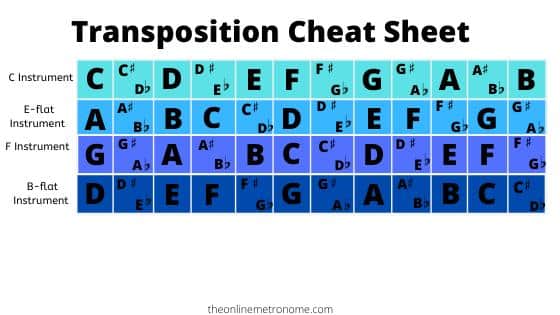
In my years of teaching, I’ve found that changing song keys is one of the most practical applications of the capo chart. It’s a skill that can transform your playing, allowing you to adapt songs to your vocal range or match other instruments effortlessly. I always encourage my students to experiment with different capo positions to find the sweet spot for their voice.
One exercise I love is taking a familiar song and systematically moving the capo up the fretboard, playing the same capo chords in each position. This not only helps you internalize the relationship between capo placement and key changes but also trains your ear to recognize how the song’s character shifts with each move. Remember, the beauty of using a capo is that you can maintain the original fingerings while exploring new sonic territories.
Creating New Chord Voicings
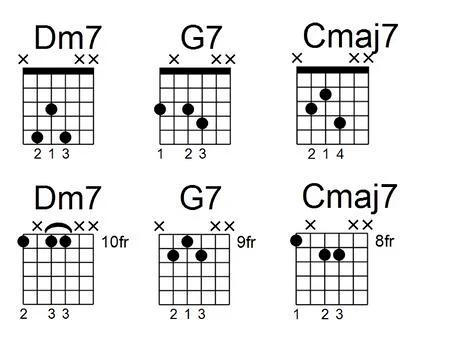
As I discovered while writing “Color Your Chords,” the capo is an invaluable tool for exploring new chord voicings. By placing the capo on different frets, you can unlock a whole new world of sonic possibilities. For instance, a simple open G shape with a capo on the 5th fret suddenly becomes a shimmering C chord with a unique timbre. This technique allows you to create rich, full-bodied chords that might otherwise be challenging to play.
Experimenting with capo positions across the fretboard not only enhances your playing but also expands your musical vocabulary. I’ve found that moving familiar chord shapes up and down the neck with a capo can inspire fresh compositional ideas and breathe new life into well-worn progressions. This approach has been particularly effective in my songwriting, allowing me to discover voicings that perfectly complement my vocal range or the mood of a piece.
Advanced Capo Techniques
Partial Capos
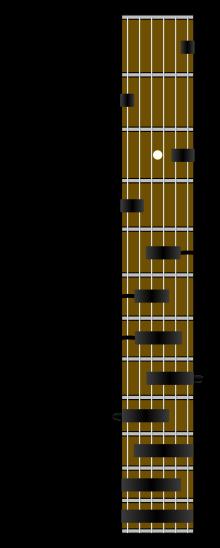
In my journey exploring advanced capo techniques, I’ve discovered the game-changing world of partial capos. Unlike standard capos, these innovative tools allow you to clamp only specific strings, opening up a realm of new possibilities. One of my favorite capo tips and tricks involves using a partial capo on the top three strings at the second fret, instantly transforming your guitar’s tuning to DADGAD without actually retuning. This technique has revolutionized my approach to fingerstyle and open-tuning-inspired playing.
Partial capos enable you to create unique chord voicings and access tonal combinations that were previously out of reach. By experimenting with different partial capo positions, you can unlock fresh sounds and inspire new compositions. The versatility of partial capos makes them an essential tool for any guitarist looking to expand their sonic palette and push the boundaries of traditional playing techniques.
Multiple Capos
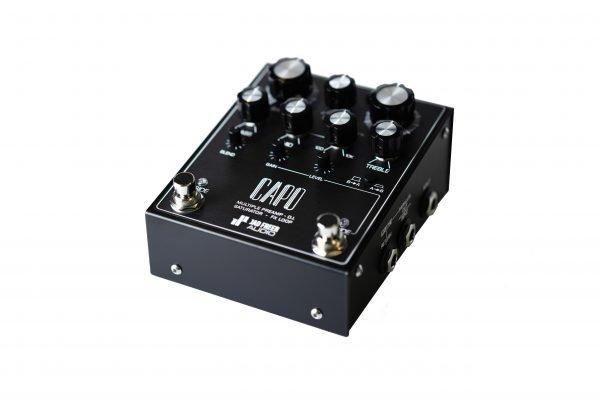
In my exploration of contemporary improvisation, I’ve discovered the fascinating world of multiple capos. This advanced technique involves using two or more capos simultaneously, opening up a realm of unique sonic possibilities. By strategically placing capos on different frets, you can create alternate tunings and complex chord voicings that would be impossible with standard capo usage. I’ve found that combining a partial capo on the lower strings with a full capo on higher frets can produce hauntingly beautiful open tunings. This approach not only expands your tonal palette but also challenges you to think differently about chord structures and melodic patterns. Experimenting with multiple capos has revolutionized my compositional process, allowing me to craft intricate arrangements that push the boundaries of traditional guitar playing.
As we delve deeper into advanced techniques, let’s explore how partial capos can further enhance your musical expression and complement the use of multiple capos.
FAQs
What is a guitar capo?
A guitar capo is a small device that clamps onto the neck of a guitar to shorten the strings’ length, effectively raising the pitch of the open strings. It allows guitarists to play songs in different keys without changing their fingerings.
How does a capo chart work?
A capo chart shows how to transpose chords when using a capo on different frets. It helps guitarists quickly determine which chords to play in the new key created by the capo’s position.
What are the benefits of using a capo?
Using a capo offers several benefits:
1. It allows you to play songs in different keys without learning new chord shapes.
2. It can make it easier to match a singer’s vocal range.
3. It enables you to achieve different tonal qualities from your guitar.
4. It simplifies playing certain chord progressions that might be difficult in the original key.
How do I transpose chords using a capo?
To transpose chords using a capo:
1. Determine the number of frets you’ve moved the capo up from the nut.
2. Count that many semitones up the musical alphabet for each chord.
3. Play the new chords in their original shapes.
For example, if you place the capo on the 2nd fret and the original chord is G, you would now play an A chord shape to produce a B chord.
What are some common capo positions and their effects?
Common capo positions and their effects include:
1. Capo on 1st fret: Raises pitch by one semitone (e.g., C becomes C#/Db)
2. Capo on 2nd fret: Raises pitch by one whole tone (e.g., C becomes D)
3. Capo on 3rd fret: Raises pitch by one and a half tones (e.g., C becomes Eb)
4. Capo on 5th fret: Raises pitch by a perfect fourth (e.g., C becomes F)
5. Capo on 7th fret: Raises pitch by a perfect fifth (e.g., C becomes G)
Conclusion
Are you ready to revolutionize your guitar playing? Let’s recap how the humble capo can be your secret weapon for musical mastery. Throughout this guide, we’ve explored the intricate world of guitar capos, from understanding their basic function to mastering advanced techniques. As a seasoned guitar educator, I can’t stress enough how crucial it is to learn guitar capo usage effectively.
Remember, the capo is more than just a tool—it’s a gateway to musical versatility. By mastering the capo chart, you’ve unlocked the ability to transpose songs effortlessly, create unique chord voicings, and expand your musical repertoire. I encourage you to experiment with different capo positions, explore partial and multiple capo techniques, and most importantly, let your creativity soar. The journey to guitar mastery is ongoing, and the capo is your trusty companion along the way. So, pick up your guitar, attach that capo, and start creating music that resonates with your soul!